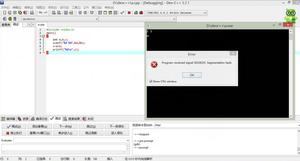Python3.1有什么新变化

- 作者
Raymond Hettinger
This article explains the new features in Python 3.1, compared to 3.0.
PEP 372: 有序字典¶
Regular Python dictionaries iterate over key/value pairs in arbitrary order.
Over the years, a number of authors have written alternative implementations
that remember the order that the keys were originally inserted. Based on
the experiences from those implementations, a new
collections.OrderedDict class has been introduced.
The OrderedDict API is substantially the same as regular dictionaries
but will iterate over keys and values in a guaranteed order depending on
when a key was first inserted. If a new entry overwrites an existing entry,
the original insertion position is left unchanged. Deleting an entry and
reinserting it will move it to the end.
The standard library now supports use of ordered dictionaries in several
modules. The configparser module uses them by default. This lets
configuration files be read, modified, and then written back in their original
order. The _asdict() method for collections.namedtuple() now
returns an ordered dictionary with the values appearing in the same order as
the underlying tuple indices. The json module is being built-out with
an object_pairs_hook to allow OrderedDicts to be built by the decoder.
Support was also added for third-party tools like PyYAML.
参见
- PEP 372 - 有序字典
PEP 由 Armin Ronacher 和 Raymond Hettinger 撰写,由 Raymond Hettinger 实现。
PEP 378: 千位分隔符的格式说明符¶
The built-in format() function and the str.format() method use
a mini-language that now includes a simple, non-locale aware way to format
a number with a thousands separator. That provides a way to humanize a
program's output, improving its professional appearance and readability:
>>> format(1234567,',d')'1,234,567'
>>> format(1234567.89,',.2f')
'1,234,567.89'
>>> format(12345.6+8901234.12j,',f')
'12,345.600000+8,901,234.120000j'
>>> format(Decimal('1234567.89'),',f')
'1,234,567.89'
The supported types are int, float, complex
and decimal.Decimal.
Discussions are underway about how to specify alternative separators
like dots, spaces, apostrophes, or underscores. Locale-aware applications
should use the existing n format specifier which already has some support
for thousands separators.
参见
- PEP 378 - 千位分隔符的格式说明符
PEP 由 Raymond Hettinger 撰写,并由 Eric Smith 和 Mark Dickinson 实现
其他语言特性修改¶
对Python 语言核心进行的小改动:
Directories and zip archives containing a
__main__.pyfile can now be executed directly by passing their name to the
interpreter. The directory/zipfile is automatically inserted as the
first entry in sys.path. (Suggestion and initial patch by Andy Chu;
revised patch by Phillip J. Eby and Nick Coghlan; bpo-1739468.)
The
int()type gained abit_lengthmethod that returns thenumber of bits necessary to represent its argument in binary:
>>> n=37
>>> bin(37)
'0b100101'
>>> n.bit_length()
6
>>> n=2**123-1
>>> n.bit_length()
123
>>> (n+1).bit_length()
124
(由 Fredrik Johansson, Victor Stinner, Raymond Hettinger 和 Mark Dickinson 在 bpo-36326 中贡献。)
The fields in
format()strings can now be automaticallynumbered:
>>> 'Sir {} of {}'.format('Gallahad','Camelot')
'Sir Gallahad of Camelot'
Formerly, the string would have required numbered fields such as:
'Sir{0}of{1}'.(由 Eric Smith在 bpo-5237 中贡献)
The
string.maketrans()function is deprecated and is replaced by newstatic methods,
bytes.maketrans()andbytearray.maketrans().This change solves the confusion around which types were supported by the
stringmodule. Now,str,bytes, andbytearrayeach have their own maketrans and translatemethods with intermediate translation tables of the appropriate type.
(由Georg Brandl在 bpo-5675 中贡献)
The syntax of the
withstatement now allows multiple contextmanagers in a single statement:
>>> withopen('mylog.txt')asinfile,open('a.out','w')asoutfile:
... forlineininfile:
... if'<critical>'inline:
... outfile.write(line)
With the new syntax, the
contextlib.nested()function is no longerneeded and is now deprecated.
(Contributed by Georg Brandl and Mattias Brändström;
appspot issue 53094.)
round(x,n)now returns an integer if x is an integer.Previously it returned a float:
>>> round(1123,-2)
1100
(由 Mark Dickinson在 bpo-4707 贡献)
Python now uses David Gay's algorithm for finding the shortest floating
point representation that doesn't change its value. This should help
mitigate some of the confusion surrounding binary floating point
numbers.
The significance is easily seen with a number like
1.1which does nothave an exact equivalent in binary floating point. Since there is no exact
equivalent, an expression like
float('1.1')evaluates to the nearestrepresentable value which is
0x1.199999999999ap+0in hex or1.100000000000000088817841970012523233890533447265625in decimal. Thatnearest value was and still is used in subsequent floating point
calculations.
What is new is how the number gets displayed. Formerly, Python used a
simple approach. The value of
repr(1.1)was computed asformat(1.1,'.17g') which evaluated to
'1.1000000000000001'. The advantage ofusing 17 digits was that it relied on IEEE-754 guarantees to assure that
eval(repr(1.1))would round-trip exactly to its original value. Thedisadvantage is that many people found the output to be confusing (mistaking
intrinsic limitations of binary floating point representation as being a
problem with Python itself).
The new algorithm for
repr(1.1)is smarter and returns'1.1'.Effectively, it searches all equivalent string representations (ones that
get stored with the same underlying float value) and returns the shortest
representation.
The new algorithm tends to emit cleaner representations when possible, but
it does not change the underlying values. So, it is still the case that
1.1+2.2!=3.3even though the representations may suggest otherwise.The new algorithm depends on certain features in the underlying floating
point implementation. If the required features are not found, the old
algorithm will continue to be used. Also, the text pickle protocols
assure cross-platform portability by using the old algorithm.
(由 Eric Smith 和 Mark Dickinson 在 bpo-1580 贡献)
新增,改进和弃用的模块¶
Added a
collections.Counterclass to support convenientcounting of unique items in a sequence or iterable:
>>> Counter(['red','blue','red','green','blue','blue'])
Counter({'blue': 3, 'red': 2, 'green': 1})
(由 Raymond Hettinger 在 bpo-1696199 中贡献。)
Added a new module,
tkinter.ttkfor access to the Tk themed widget set.The basic idea of ttk is to separate, to the extent possible, the code
implementing a widget's behavior from the code implementing its appearance.
(由 Guilherme Polo 在 bpo-2983 中贡献。)
The
gzip.GzipFileandbz2.BZ2Fileclasses now supportthe context management protocol:
>>> # Automatically close file after writing
>>> withgzip.GzipFile(filename,"wb")asf:
... f.write(b"xxx")
(由 Antoine Pitrou 贡献。)
The
decimalmodule now supports methods for creating adecimal object from a binary
float. The conversion isexact but can sometimes be surprising:
>>> Decimal.from_float(1.1)
Decimal('1.100000000000000088817841970012523233890533447265625')
The long decimal result shows the actual binary fraction being
stored for 1.1. The fraction has many digits because 1.1 cannot
be exactly represented in binary.
(由Raymond Hettinger 和 Mark Dickinson贡献。)
The
itertoolsmodule grew two new functions. Theitertools.combinations_with_replacement()function is one offour for generating combinatorics including permutations and Cartesian
products. The
itertools.compress()function mimics its namesakefrom APL. Also, the existing
itertools.count()function now hasan optional step argument and can accept any type of counting
sequence including
fractions.Fractionanddecimal.Decimal:>>> [p+qforp,qincombinations_with_replacement('LOVE',2)]
['LL', 'LO', 'LV', 'LE', 'OO', 'OV', 'OE', 'VV', 'VE', 'EE']
>>> list(compress(data=range(10),selectors=[0,0,1,1,0,1,0,1,0,0]))
[2, 3, 5, 7]
>>> c=count(start=Fraction(1,2),step=Fraction(1,6))
>>> [next(c),next(c),next(c),next(c)]
[Fraction(1, 2), Fraction(2, 3), Fraction(5, 6), Fraction(1, 1)]
(由 Raymond Hettinger 贡献。)
collections.namedtuple()now supports a keyword argumentrename which lets invalid fieldnames be automatically converted to
positional names in the form _0, _1, etc. This is useful when
the field names are being created by an external source such as a
CSV header, SQL field list, or user input:
>>> query=input()
SELECT region, dept, count(*) FROM main GROUPBY region, dept
>>> cursor.execute(query)
>>> query_fields=[desc[0]fordescincursor.description]
>>> UserQuery=namedtuple('UserQuery',query_fields,rename=True)
>>> pprint.pprint([UserQuery(*row)forrowincursor])
[UserQuery(region='South', dept='Shipping', _2=185),
UserQuery(region='North', dept='Accounting', _2=37),
UserQuery(region='West', dept='Sales', _2=419)]
(由 Raymond Hettinger 在 bpo-1818 中贡献。)
The
re.sub(),re.subn()andre.split()functions nowaccept a flags parameter.
(由 Gregory Smith 贡献)
The
loggingmodule now implements a simplelogging.NullHandlerclass for applications that are not using logging but are calling
library code that does. Setting-up a null handler will suppress
spurious warnings such as "No handlers could be found for logger foo":
>>> h=logging.NullHandler()
>>> logging.getLogger("foo").addHandler(h)
(由 Vinay Sajip 在 bpo-4384 中贡献。)
The
runpymodule which supports the-mcommand line switchnow supports the execution of packages by looking for and executing
a
__main__submodule when a package name is supplied.(由 Andi Vajda 在 bpo-4195 中贡献。)
The
pdbmodule can now access and display source code loaded viazipimport(or any other conformant PEP 302 loader).(由 Alexander Belopolsky 在 bpo-4201 中贡献。)
functools.partialobjects can now be pickled.
(Suggested by Antoine Pitrou and Jesse Noller. Implemented by
Jack Diederich; bpo-5228.)
Add
pydochelp topics for symbols so thathelp('@')works as expected in the interactive environment.
(由 David Laban 在 bpo-4739 中贡献。)
The
unittestmodule now supports skipping individual tests or classesof tests. And it supports marking a test as an expected failure, a test that
is known to be broken, but shouldn't be counted as a failure on a
TestResult:
classTestGizmo(unittest.TestCase):
@unittest.skipUnless(sys.platform.startswith("win"),"requires Windows")
deftest_gizmo_on_windows(self):
...
@unittest.expectedFailure
deftest_gimzo_without_required_library(self):
...
Also, tests for exceptions have been builtout to work with context managers
using the
withstatement:deftest_division_by_zero(self):
withself.assertRaises(ZeroDivisionError):
x/0
In addition, several new assertion methods were added including
assertSetEqual(),assertDictEqual(),assertDictContainsSubset(),assertListEqual(),assertTupleEqual(),assertSequenceEqual(),assertRaisesRegexp(),assertIsNone(),and
assertIsNotNone().(由Benjamin Peterson 和 Antoine Pitrou 贡献。)
The
iomodule has three new constants for theseek()method
SEEK_SET,SEEK_CUR, andSEEK_END.The
sys.version_infotuple is now a named tuple:>>> sys.version_info
sys.version_info(major=3, minor=1, micro=0, releaselevel='alpha', serial=2)
(由 Ross Light 在 bpo-4285 中贡献。)
The
nntplibandimaplibmodules now support IPv6.(由 Derek Morr 在 bpo-14807 和 bpo-1664 中贡献。)
The
picklemodule has been adapted for better interoperability withPython 2.x when used with protocol 2 or lower. The reorganization of the
standard library changed the formal reference for many objects. For
example,
__builtin__.setin Python 2 is calledbuiltins.setin Python3. This change confounded efforts to share data between different versions of
Python. But now when protocol 2 or lower is selected, the pickler will
automatically use the old Python 2 names for both loading and dumping. This
remapping is turned-on by default but can be disabled with the fix_imports
option:
>>> s={1,2,3}
>>> pickle.dumps(s,protocol=0)
b'c__builtin__\nset\np0\n((lp1\nL1L\naL2L\naL3L\natp2\nRp3\n.'
>>> pickle.dumps(s,protocol=0,fix_imports=False)
b'cbuiltins\nset\np0\n((lp1\nL1L\naL2L\naL3L\natp2\nRp3\n.'
An unfortunate but unavoidable side-effect of this change is that protocol 2
pickles produced by Python 3.1 won't be readable with Python 3.0. The latest
pickle protocol, protocol 3, should be used when migrating data between
Python 3.x implementations, as it doesn't attempt to remain compatible with
Python 2.x.
(由 Alexandre Vassalotti 和 Antoine Pitrou 在 bpo-6137 中贡献。)
A new module,
importlibwas added. It provides a complete, portable,pure Python reference implementation of the
importstatement and itscounterpart, the
__import__()function. It represents a substantialstep forward in documenting and defining the actions that take place during
imports.
(由 Brett Cannon 贡献。)
性能优化¶
Major performance enhancements have been added:
The new I/O library (as defined in PEP 3116) was mostly written in
Python and quickly proved to be a problematic bottleneck in Python 3.0.
In Python 3.1, the I/O library has been entirely rewritten in C and is
2 to 20 times faster depending on the task at hand. The pure Python
version is still available for experimentation purposes through
the
_pyiomodule.(由 Amaury Forgeot d'Arc 和 Antoine Pitrou 贡献。)
Added a heuristic so that tuples and dicts containing only untrackable objects
are not tracked by the garbage collector. This can reduce the size of
collections and therefore the garbage collection overhead on long-running
programs, depending on their particular use of datatypes.
(由 Antoine Pitrou 在 bpo-4688 中贡献。)
Enabling a configure option named
--with-computed-gotoson compilers that support it (notably: gcc, SunPro, icc), the bytecode
evaluation loop is compiled with a new dispatch mechanism which gives
speedups of up to 20%, depending on the system, the compiler, and
the benchmark.
(由 Antoine Pitrou 以及其他一些参与者在 bpo-4753 中贡献。)
The decoding of UTF-8, UTF-16 and LATIN-1 is now two to four times
faster.
(由 Antoine Pitrou 和 Amaury Forgeot d'Arc 在 bpo-4868 中贡献。)
The
jsonmodule now has a C extension to substantially improveits performance. In addition, the API was modified so that json works
only with
str, not withbytes. That change makes themodule closely match the JSON specification
which is defined in terms of Unicode.
(由 Bob Ippolito 在 bpo-4136 中贡献。并由 Antoine Pitrou 和 Benjamin Peterson 转换为Py3.1)
Unpickling now interns the attribute names of pickled objects. This saves
memory and allows pickles to be smaller.
(由 Jake McGuire 和 Antoine Pitrou 在 bpo-5084 中贡献。)
IDLE¶
IDLE's format menu now provides an option to strip trailing whitespace
from a source file.
(由 Roger D. Serwy 在 bpo-5150 中贡献。)
构建和 C API 的改变¶
Changes to Python's build process and to the C API include:
Integers are now stored internally either in base 2**15 or in base
2**30, the base being determined at build time. Previously, they
were always stored in base 2**15. Using base 2**30 gives
significant performance improvements on 64-bit machines, but
benchmark results on 32-bit machines have been mixed. Therefore,
the default is to use base 2**30 on 64-bit machines and base 2**15
on 32-bit machines; on Unix, there's a new configure option
--enable-big-digitsthat can be used to override this default.Apart from the performance improvements this change should be invisible to
end users, with one exception: for testing and debugging purposes there's a
new
sys.int_infothat provides information about theinternal format, giving the number of bits per digit and the size in bytes
of the C type used to store each digit:
>>> importsys
>>> sys.int_info
sys.int_info(bits_per_digit=30, sizeof_digit=4)
(由 Mark Dickinson在 bpo-4258 贡献)
The
PyLong_AsUnsignedLongLong()function now handles a negativepylong by raising
OverflowErrorinstead ofTypeError.(由 Mark Dickinson 和 Lisandro Dalcrin 在 bpo-5175 中贡献。)
Deprecated
PyNumber_Int(). UsePyNumber_Long()instead.(由 Mark Dickinson在 bpo-4910 贡献)
Added a new
PyOS_string_to_double()function to replace thedeprecated functions
PyOS_ascii_strtod()andPyOS_ascii_atof().(由 Mark Dickinson在 bpo-5914 贡献)
Added
PyCapsuleas a replacement for thePyCObjectAPI.The principal difference is that the new type has a well defined interface
for passing typing safety information and a less complicated signature
for calling a destructor. The old type had a problematic API and is now
deprecated.
(由 Larry Hastings 在 bpo-5630 中贡献。)
移植到 Python 3.1¶
This section lists previously described changes and other bugfixes
that may require changes to your code:
The new floating point string representations can break existing doctests.
For example:
defe():
'''Compute the base of natural logarithms.
>>> e()
2.7182818284590451
'''
returnsum(1/math.factorial(x)forxinreversed(range(30)))
doctest.testmod()
**********************************************************************
Failedexample:
e()
Expected:
2.7182818284590451
Got:
2.718281828459045
**********************************************************************
The automatic name remapping in the pickle module for protocol 2 or lower can
make Python 3.1 pickles unreadable in Python 3.0. One solution is to use
protocol 3. Another solution is to set the fix_imports option to
False.See the discussion above for more details.









